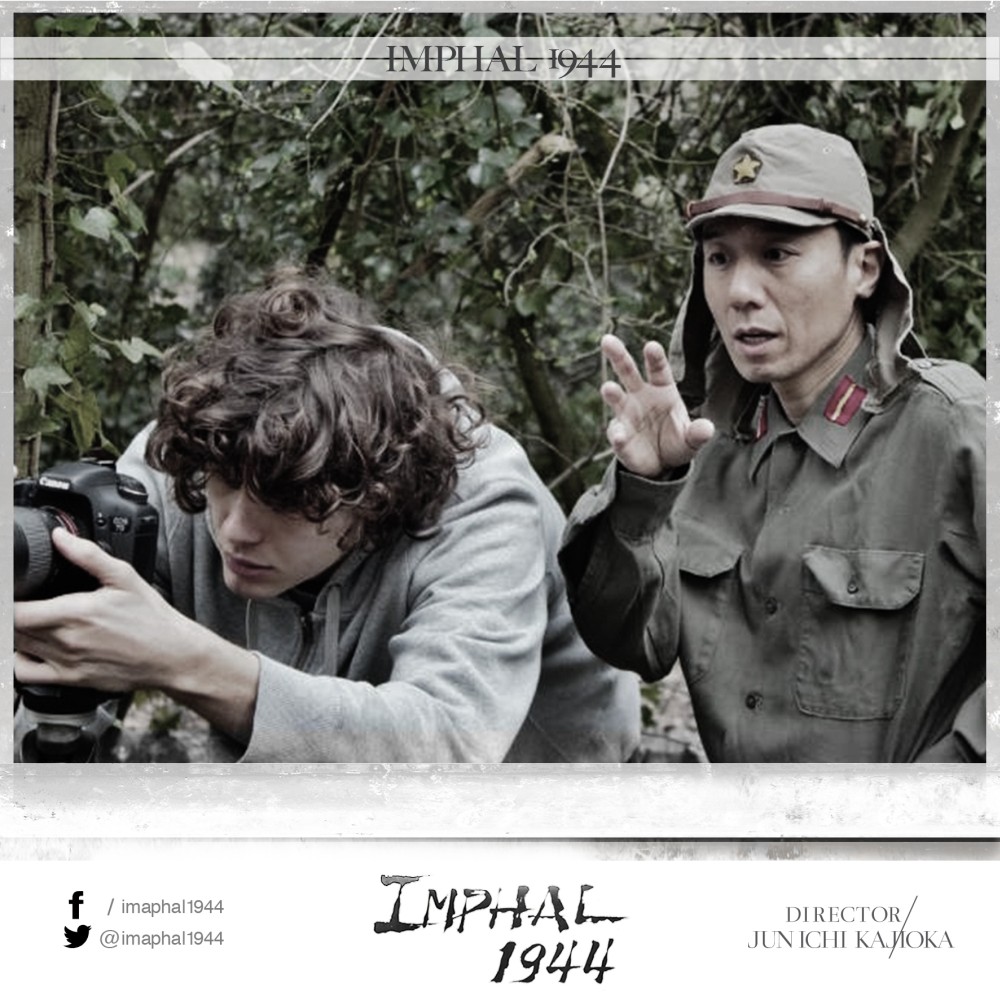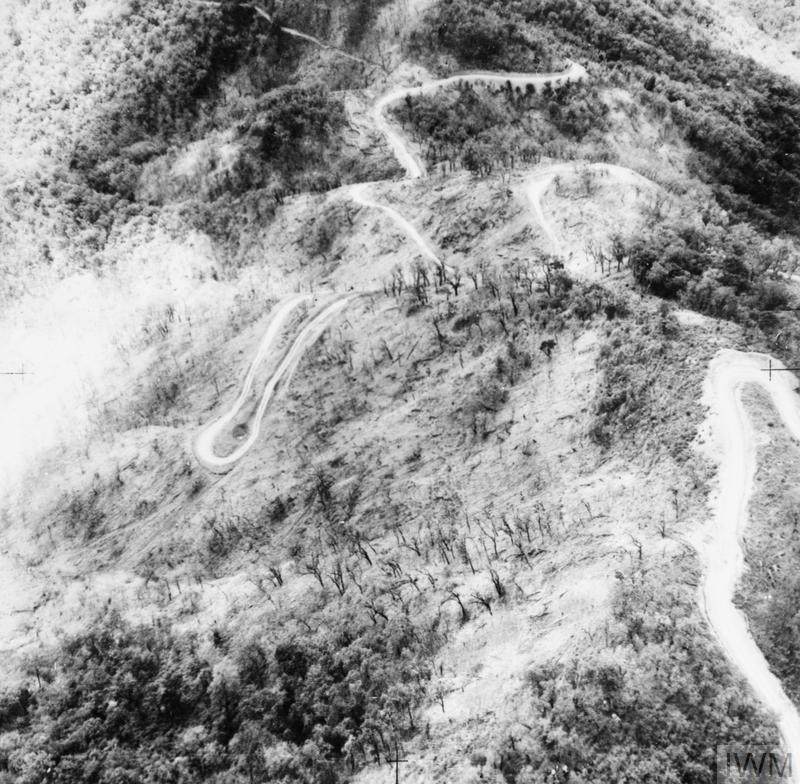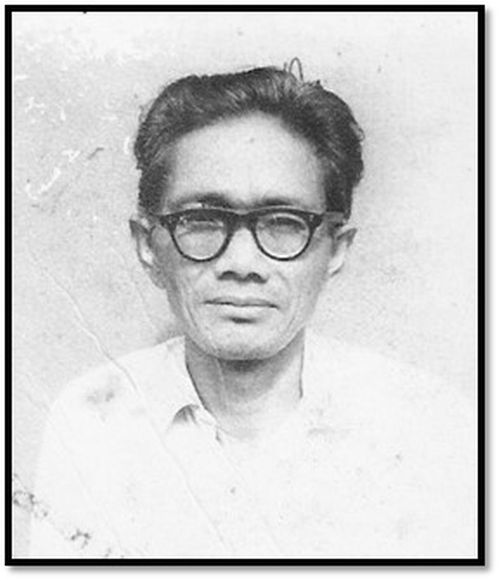My memories of Imphal from 1941
- Part 17 -
Dr Mohendra Irengbam *

Filming of 'IMPHAL 1944' :: Pix courtesy - Junichi Kajioka
I know what Voltaire, the French Enlightenment philosopher, said: "History consists of a series of imaginative inventions." But, modern Manipuri historians might find just coherence in my vigorous insistence that World War II was an epoch in Manipur's history, like a 'rite of passage'. It was a social process of transitioning from one accepted social role to another with a beginning and an end.
WWII, or Japan Lan to Manipuris, changed the outlook of complacent Meiteis from a lethargic to an energetic one, and from typical narcissistic Meiteis, who hold firmly that 'all those who differ from them in any respect are ignorant' to a logical person, who knows what he is talking about.
When WWII did arrive visibly in Manipur in 1944 with warplanes, tanks, armoured cars, many Divisions of the Commonwealth Army: Indians, Africans, Gurkhas, and American GIs, Imphal was already under military administration. Many houses were requisitioned by the Allied Army.
The main Japanese thrust from Burma towards Imphal from the south by their crack 33rd Division, known as the "White Tigers, tried to cut off General Slim's 17th Indian Division, known as the Black Cats" south of Imphal, along the Tiddim Road. The Division was carrying out a fighting withdrawal into the defensive box around the key areas of Imphal in March 1944, when the Japanese tried their favourite tactics of blocking its retreat and destroying it at Tiddim Road, around the 109 milestone.
The battle of Imphal began on March 15 1944 along Tiddim Road, which stretched from Tiddim Village in the Chin Hills in Burma right up to Imphal. It took place along the dozen miles or so between Bishnupur village and former suspension bridge over the Leimatak River. During the next two months, Potsangbam and Ningthoukhong villages were the scenes of ferocious battles. The battle ended on June 22 1944 in favour of the Allied forces.
The eponymous "Battle of Imphal" was not a battle fought in Imphal, but actually the fighting was in the regions surrounding the present city of Imphal. "It was mainly for the control of the roads and tracks radiating out from the centre, on a ninety-mile arc all around the Imphal plain; from Kanglatongbi ten miles north of Imphal Town, through the 5,833-foot twin peaks of Ningshigum, to Yaingangpokpi on the Ukhrul Road, Wangjing and Tengnoupal on the Tamu-Palel Road, Shugnu south of Loktak Lake and Torbung on the Tiddim Road." ((Maj Gen Julian Thompson, Forgotten voices of Burma).

Tiddim Road, about 109 milestone where the Japanese tried to cut off the 17th Indian Division
Photo Credit: www.iwm.org.uk - IWM MH 3087
In the villages elsewhere in Manipur, people were engaged in their daily work in the paddy fields while the refugees from Imphal, were left indolent as there was nothing they could do. They simply cottoned on to the hope that, the War would end sometime.
While the battle was raging around Imphal town, Khwairamband Bazaar in the centre of Imphal, was like a ghost town, while bazaars at Singjamei, Kongba, and Lamshang were thriving. There was also a little female bazaar, near a large military establishment at the foothills of Leimakhong Hill ranges, selling knick-knacks for the Indian soldiers. Further up the Leimakhong, across the Sanahal Lokchao River, there was the only Hydro-electric power house that my father was running. It was about half a kilometre up a gentle climb.
A huge military establishment at the foothills of Leimakhong was established in 1943-44. It was full of activity as I noticed, whenever I was going up to the power house, sometimes with my father and sometimes alone. It was between the present headquarters of the 57 Mountain Division of the Indian Army and the Lokchao River. There was constant traffic of large military vehicles and medium-sized ambulance cars with Indian Army drivers, running up and down Leimakhong from Feidinga.
Near the present-day electric power house at Leimakhong and further down the foothills, a large military base hospital, known as 'Number 183 Military hospital' was located, in tents, along with 'Number 41 Indian General Hospital'. They were established in 1943-45 to treat wounded soldiers evacuated from in the front lines around Imphal.
They had British doctors, and Australian nurses of Queen Alexandra's Imperial Military Nursing Service. The whole complex was located on the left side of the main road running up to the Sanahal Lokchao Military camp. Some of these nurses used to come up for a swim with their boyfriends on hot summer days, in the small cool reservoir for the hydro-electric plant on top of the hill.
This large hospital was separated into two halves by a carriageway for ambulance cars, which branched off from the main road. The smaller hospital area on the west side of the carriageway
was for British soldiers and the bigger one in the east for Indian soldiers. The best part of the hospital for me, was the big canteen. My father used to take me there to buy all sorts of delicacies like chocolate and canned food stuffs, such as garden peas, pears, condensed or evaporated milk and Kraft-K cheese, baked beans and so on.
Villagers in our Senjam-Chirang, were intermittently reminded of the war by Indian troops patrolling, apparently looking for Japs. Sometimes, Gurkhas in armoured cars patrolled through the village. At times, Indian Army officers would come in the village to shoot birds from the trees. Some British officer on a motorbike, came sometimes and made enquiries if there was any problem with stray soldiers. Once there were about a dozen Chinese soldiers traipsing through the village in a surreptitious manner.
Just outside our village, at a grazing field, there was a small British radar station with the personnel wearing British Air Force uniforms. Life in our village otherwise, was tranquil and undisturbed by the war going around other villages both in the plain and the hills. Life trudged along at a snail's pace. It was mind-numbing and humdrum except for peripatetic showbusiness Meitei men and women, such as magicians and circus troupes, who were constantly arriving to entertain the war weary villagers. There were seasonal khubak Ishei and Bashok singers.
I enjoyed going out with slightly older boys from the village to tend cows in the pastures and coming back riding on the back of a buffalo along with other boys. There was no schooling. Rather, we boys went out swimming naked in small ponds outside the village, filled with big leeches. When we came out of the water we had to be quick to pull them off from our bodies before they had time to suck our blood. We often went out at night to have a picnic in a vacant paddy field, cooking rice inside cut-out bamboo stalks with burning straw.
As I grew a bit older I became more inquisitive. I began to follow villagers to see how they ploughed the field. A man would plod behind a hook-shaped plough, tipped with a metal plate, which was pulled by two oxen with a yoke on their necks. When the farmer shouted 'err…err', the left one responded and with 'titi…titi' the right one reacted. I watched how men and women transplanted growing rice seedlings from a nursery in a previously flooded field, which was under about 12 cm of water and banked with low mud walls.
I often went to see how villagers, men and women, harvested the paddy in the months of September-October, when the kernels of the paddy turned golden-brown. They cut the ripe paddy plants with sickles, leaving stalks about 15 cm deep and then left them to dry in the sun for a few days. I saw how they separated the paddy grains from the stalks by threshing with three-pronged wooden hay forks and winnowing in a shallow round basket made of bamboo, about 100cm across.
During the procedure, wind would blow away the lighter stuff while heavier grains would fall back. Once done, they would fill standard size gunny bags that held one Sangbai (30kg) each, of which 14 Sangbai per Pari (one hectare) would be delivered to the owners of the paddy fields while keeping the rest of the produce for themselves.
Once the formalities were over, they gathered the paddy stalks in bundles, which were left to dry in the sun in a heap for some days before being loaded onto bullock carts as hay for home consumption by their cattle, and for sale to some people in Imphal, who kept cows for milk, and for poor people who used them for cooking.
Our village like any other, had no dispensary or police station. People treated themselves with indigenous medicine of some sort. Thieving, burglary, and crime were rare as everybody knew everybody. Babies of pregnant women were delivered by indigenous midwives. Unlike other villages in India, every family had a house and ingkhol as well as space for kitchen gardening. They were self-sufficient.
My life in the village continued until early 1945 when the Japan Lan came to an end, though not completely in Manipur. My eldest brother Gokulchandra, a civil engineer, had to return to Imphal
as the state Public Works Department (PWD) had begun to function temporarily, with Khomdram Angangjao as the Head of the Department, and his homestead at Tera Keithel, as the office.
As our home at Uripok was still occupied by military personnel, my brother had to stay with a Brahmin family at Bamon Leikai. He also brought me to Imphal for schooling. I was admitted to class IV at Moirangkhom Upper Primary School. The war-torn School was in squalid settings with bamboo benches to sit on. The teachers were very good though. They helped me to qualify with a merit scholarship in 1946, for Johnstone High School in its old building.
As I was without schooling for three years, my brother found a bright young man, who became my teacher at home. His name was RK Maipaksana (Oct 11 1924- Oct 18 1993). He was living at Singjamei by the Imphal River. I was very sad when his son RK Dilip, who returned home from his studies in England in 1993, telephoned to tell me that his father has expired at the age of. 70.

RK Maipaksana died on October 18 1993
RK Maipaksana, after his matriculation, worked as a community journalist. In his young adulthood he developed political passion as he became concerned about the political issues prevailing in Manipur at that time. This interest with his intellectual propensity, spurred his engagement with politics, political values and political processes. Eventually he adopted, what is known in political science, unconventional political behaviour that involved protest politics and new social movements for collective mobilisation to defend common interests. He was an autodidact in politics.
He was involved in the first ever Satyagraha movement in Manipur on September 19 1947, along with a couple of de novo politicians. They were pitching for democracy in Manipur. It was the harbinger for the end of the feudal monarchical system that came in 1949. After doing his BA from Calcutta he became an eminent political activist.
It always fills me with conscious pleasure when I engage my mind into overdrive to travel back in time, to the days of post-war childhood. While staying at Bamon Leikai, I along with three or four boys would saunter all the way to the war-ravaged Imphal town centre, to see matinee shows of various children's Hindi films. We didn't know any Hindi. We just enjoyed the stunts in children's movies, such as Hunter Wali, Passing Shaw and so on.
There were three cinema Halls: Friends' Talkies, MNB Hall and Victory hall in the Sadar Bazaar. A third class ticket was one sikki – a quarter of a rupee. We sat on long wooden benches. Sometimes, when all the seats were booked, we would be allowed to sit at the back of the screen and watch the flicks left-handed. Many a time the show would be delayed as they waited for more customers to fill the hall, when in a chorus, we would be yelling.
From Bamon Leikai we had to cross the Imphal River to Moirangkhom and back, in a long dugout canoe that was tied to a rope stretched across the river. Everybody in the canoe had to use their hands to manoeuvre across. Only one bridge was built over at Singjamei, about 40km down south, which connected Imphal West with Kongba Bazaar in Imphal East. The British were very parsimonious and cost-effective. And the Meiteis knew no better.
The Imphal River in summer had a low level of water, about a foot deep and the banks were so steep that people living by the river, had to cut steps down the bank to reach the water. While in spate in the rainy season, it was huge. Though I was a small boy, I would jump into the fast flowing river and swim across, carried by the current, to collect many floating empty bottles, the remnants of the War, wherever they were coming from.
In early 1946, our family returned home at Uripok. So came my brother and I. There were still some Indian Army units occupying a few houses in the neighbourhood. I was still unsettled about my life. It is difficult to explain. It was the celebration of Indian independence on August 15 1947 that gave me peace of mind.
The independence of India - the 'Jewel in the Crown', led to freedom of other Afro-Asian countries in the British Empire, in a domino effect. Britain, bankrupt by WWII, lacked the will to maintain its empire. The ageing Conservative Prime Minister Churchill, who was against giving independence to India, was thrown out by the electorate who were hungry, jobless and homeless. The new, Labour Prime Minister Clement Atlee was with the people, and he granted Indian independence.
During the height of the War, the political system in Manipur showed no visible effect on the daily life of Meiteis. They were quite 'free' in a way. There were no social elites. Nor were there stringencies of their religion dictated by the Brahma Sabha. The Maharaja's rule was no more pervasive, evocative or adjudicative. General resources for living were scaffolded.
In the immediate postwar period, there was an imperceptible change among the literate, in their socio-political thinking. There was an awakening of a subtle change towards democracy and an acceptance that a monarchical system was at the cost of personal freedom. There was also a marked cultural and economic shift in Manipur, as it was throughout the entire world. WWII is credited with bringing America out of the Great Depression.
The hyperinflation of Indian rupees during the War, while strategically causing famine in Bengal, had a trickle-down effect on the paltry Gross Domestic Product (GDP) of Manipur. It gave a much needed shot in the arm. For many, the War gave unemployed Meitei men and women some productive work, such as in the supply of various essential commodities of fresh vegetables, cows' milk and so on. They made a lot of money from road-building works along the whole length of Indo-Burma Road from Dimapur to Moreh.
On the plus side of the War, like the rise of the Phoenix from the ashes, many Meiteis after the end of the war, were able to construct brick buildings at Khwairamband Bazaar on the bombed out plots that previously belonged to Marwaris. Many business enterprises sprang up, though on a small scale. People were able to buy salvaged automobiles and had enough money to buy petrol. Almost every family had a bicycle. People were better dressed and happier. In general, there was a higher standard of living.
Many were able to fly out to Calcutta for holiday or business. The fare was affordable and the time was very short. You could reach Calcutta in four hours rather than two days. More students went to colleges further afield than Gauhati, to Calcutta and Allahabad. I went to Bombay. It was something almost providential about changing the face of Imphal through the vagaries of history. The War opened the eyes of Manipuris after a long nap, like Rip Van Winkle, who fell asleep for 20 years.
It was partly due to the foresight and prudence of Mr Gimson, who knew how the Second Nupi lan erupted in 1941, because of famine caused by the export of rice from Manipur by Marwaris in collusion with Churachand Maharaja. Gimson, refused to renew the deeds (patta) of the Marwaris at Khwairamband Bazaar in Imphal, which was in the British Reserve.
Only a few very old Marwari families, such as Kasturichand, were allowed to return. Kasturi was in the good books of Churachand Maharaja before the war. His family bought and sold a car to Churachand for 3,000 rupees in the early 1930s. I met Kasturichand a few times, visiting him at his home, as a doctor. The Marwaris in Imphal, have since done a lot of good in making Imphal a prosperous city.
Author's website: drimsingh.com
* Dr Mohendra Irengbam wrote this article for e-pao.net
The writer can be contacted at irengbammsingh(AT)gmail(DOT)com
This article was webcasted on February 14 2021 .
* Comments posted by users in this discussion thread and other parts of this site are opinions of the individuals posting them (whose user ID is displayed alongside) and not the views of e-pao.net. We strongly recommend that users exercise responsibility, sensitivity and caution over language while writing your opinions which will be seen and read by other users. Please read a complete Guideline on using comments on this website.








